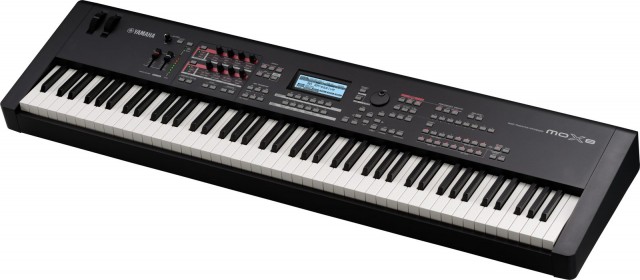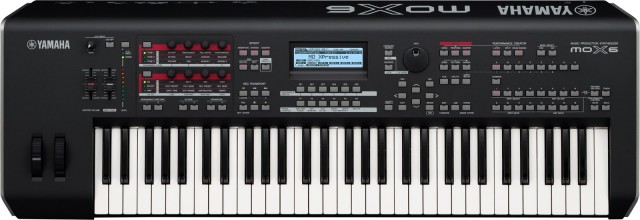While Roland this week is pushing their JP-80 and celebrating a 30-year milestone (the Jupiter-8), Yamaha has a different tack. They’re talking about the 10-year anniversary of the MOTIF workstation line, and introducing a version that’s actually easier to lift and afford. That could be friendly to the current economic tough times. But with all that people love their software synths, can Yamaha make a compelling case to the computer user, too? I put Yamaha on the spot to answer that.
First, here are the specs:
- MOTIF XS sounds, with 1,217 voices and 355 MB of waveforms. (Okay, that’s nothing to HALion’s 15 GB of sounds on a computer, but Yamaha promises content with “Expanded Articulation” features.)
- Virtual Circuit Modeling and MOTIF XS synth engine, with 18 filter types.
- 256 performance patterns, 6,720 arpeggiator patterns, MOTIF XS four-part arpeggio engine.
- USB audio/MIDI interface to record directly to a PC – 4-in, 2-out, stereo input for vocals or instruments/guitars.
- Onboard sequencer and direct-to-sequencer recording so you can use the keyboard as a sketchpad.
- MIDI controller functionality.
None of that is terribly earth-shaking; where the MOX line is worth mentioning is on weight, size, and cost. The MOX6 weighs 15.4 pounds with 61 semi-weighted keys; the MOX8 gives you 88 Graded Hammer Standard keys in 32.6 pounds.
MOX6: US$1199.99 MAP
MOX8: US$1699.99 MAP
That still isn’t quite an impulse buy, but there isn’t a whole heck of a lot of competition, particularly if you want a lightweight, playable hammer-action keyboard with these kinds of features. (Roland and Kurzweil compete in the same space, but only Kurzweil I think is on the same level for pianist-friendly hammer action keybeds.)
In fact, if you look at it this way – a keyboard with controllers and a real Yamaha keybed that you can still lift – the MOX fills a long-quiet spot in the market.
Having onboard sounds is a nice backup, but for most of us who are addicted to superior-sounding soft synths, half a gig of MOTIF sounds just won’t cut it. (Side note: I really do think there’s something to the Japanese aesthetic of miniaturized sample content. I’m stunned engineers at these makers can voice these things as well as they do.)
So, I asked Athan Billias of Yamaha’s Pro Audio and Combo Division to tell us more about the computer workflow and keybed. It brings up features you might miss, like controller capabilities, using the sequencer and arpeggiator with other gear, and other details.
Keybed: Yamaha’s keybeds are some of the best-liked away from actual pianos, so this comes as good news: “The Graded Hammer Standard is what we use on many of our digital pianos- the P95, etc,” says Athan. “It’s a graded hammer action that was designed to be lighter and allow for a more streamlined design than the Clavinova’s, but uses a similar mechanism.” Now, it is lighter – otherwise the keyboard would weigh more – but if portability is key, this could be a player.
Streaming from the audio engine: With USB onboard, being able to record the internal sound bank is essential; I saw commenters elsewhere asking about this. The answer is, yes, you can: “It is a 4 in ( to the computer ) 2 out interface. So yes, you can stream directly from the synth engine will also recording the L&R analog inputs.”
USB audio drivers: The keyboard isn’t class-compliant, says Athan, because it’s both multi-channel audio and multi-port MIDI. (I believe the latter is the issue.) You’ll need Yamaha drivers – so, no Linux / iPad.
Computer integration: With inexpensive controller keyboards available, Yamaha has a little something to prove to convince computer users. They’re obviously thinking of that use case, as they include soft synths in the box. Here’s Athan’s argument.
I think this is the coolest thing about the MOX. So let’s talk computer integration.
The MOX comes with Cubase AI of course, but it also has a suite of other software.
YC-B3 – Yamaha Organ Modeling VST soft synth
Prologue – Steinberg Virtual Analog softsynthMOX VST editor – This turns the hardware into a VST so you can treat the hardware exactly like a softsynth. Save your project, open a month later and it recalls the setting of your hardware exactly as they were when you were last working on the project.
Remote Editor- The remote mode turns the MOX into a very comprehensive DAW and VST controller. There is an AI knob which means that rest the mouse over any parameter in Cubase and the AI knob can tweak it. You can use the Remote Editor to select almost anything in Cubase to be controlled by buttons on the MOX.
You can open, select and tweak VSTs , control the EQs of audio channels, open and close the mixers and other windows and many other things.
However, it is not just the software. The MOX is an audio interface so you can play back your VSTs audio out through the MOX. A MOX, some VSTs and a laptop are all you need ( besides a PA system) to play live. The MOX has a DAW level control on the front panel which is the output from your computer.
Sequencer / arpeggiator: Okay, actually, I find this potentially the coolest feature. The sequencer can record internal MIDI or external MIDI, so you can use the keyboard as a sketchpad or use it to sequence hardware. I’m not terribly familiar with the MOTIF sequencers, so I have to give this another try to see how usable it is, but it is one advantage of workstation-style keyboards – here, without all that extra cruft (and heft, and cost) you don’t need or want.
Also, a MIDI output switch lets you use the arpeggiator and patterns to sequence your external MIDI instruments.
Otherwise, this is effectively a MOTIF XS in the guts, just with less weight and cost. That’s, um, how I expect to celebrate my next birthday/anniversary, I hope.
This isn’t a review, but this looks like a contender – and I’d love to stack the Kurzweil and Yamaha offerings against each other. Cheap controllers are nice, but having a superior keybed and some useful functions and (even just as a backup) standalone sounds has some appeal, without feeling like your keyboard is trying to be another computer.
The only unfortunate detail is that the keyboard would share the name of nuclear fuel at a most inopportune time. Then again, if I plug it in here in New York, there’s a 30% chance I’m running off nuclear fuel, too. Think of it as short for “moxie” instead.


